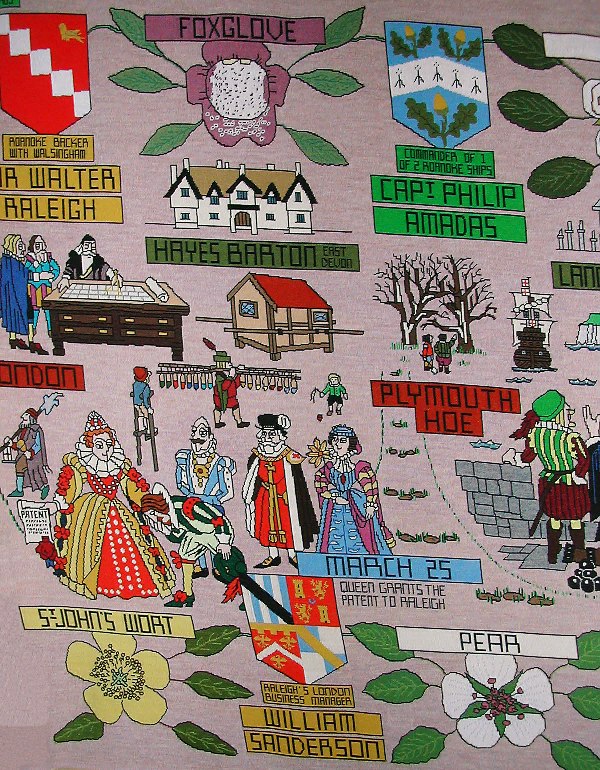|
Back to 1584 Menu

The top illustration is
of Hayes Barton, Sir Walter Raleigh’s birthplace
in East Devon. It can still be seen.
The main scene shows Sir Walter Raleigh at court in London on 25 March being granted
a Patent by Queen Elizabeth to plant a colony in the land he has named Virginia in North America in honour of her celebrated,
and perhaps notional, chastity. The colony is not only designed to extract the natural resources of a region that the Spanish
have written off as not worth the trouble of adding to their empire but will be useful for use as a base for raiding the Spanish
treasure fleets on the Caribbean.
Watching the event at the palace are three courtiers, one of whom, the third on the left is Raleigh’s
London business manager who lives in Islington, William Sanderson. Sanderson (arms shown here) is not just a get
rich quick financier but, like an increasing number of people of influence, vastly interested in overseas exploration. To
this end he has commissioned master craftsman Molyneux to make two navigational globes to help mariners. (These globes
are still in existence today, owned by the Middle temple in London).
Shown behind the event at Court are scenes from everyday England this year. On the left is the bellman
(watchman) walking the streets and crying out the hours “Tis eight of the clock and all is well” as he makes his
rounds. Two children are seen at play, one on stilts and the other with his favourite toy, a whipping top. Passing by is a
travelling shoemaker whilst near him is shown a passenger litter, the taxi of the time, designed to be operated by two porters
who have to be fit and young to carry such a heavy load through the muck and the mire of the streets for a living.
To the left
of the litter stands Dr John Dee (arms shown here). He is explaining and discussing some charts
with two sea captains. A Welshman by birth he now lives at Mortlake in Surrey and is a renowned mathematician cartographer
and astrologer who has been asked by the Queen to draw up hydrographical and geographical descriptions of newly discovered
countries.
|
 |
|
|
|
 |
|

FOXGLOVE Digitalis purpurea. ‘Foxglove boiled in water or wine, and drunken,
doth cut and consume the thicke toughnesse of grosse and slimie flegme and naughtie humours’. Gerard.
ST JOHN’S WORT Hypericum. ‘S John’s wort with his floures and
seed boyled and drunken, provoketh urine, and is right good against the stone in the bladder, and stoppeth the laske’.
Gerard.
PEAR Pyrum. ‘The
harsh and austere Peares may with good successe be laied upon hot swellings in the beginning, as may the leaves of the tree,
which do both binde and coole’. Gerard.
|
 |
|
|
|

